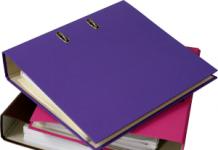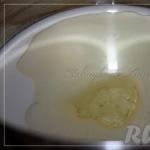A fixed asset is an expensive accounting object intended for long-term use in business activities. These include buildings, units, machines, land plots and other objects with a value in accounting more than 40,000 rub., and at NU – 100,000 rub. and service life more than 12 months.
The rules for reflecting transactions with fixed assets are prescribed in PBU 6/01. The unit of account is inventory object. At the time of acquiring fixed assets, the accountant debits account 08 or 07.
After the asset is ready for commissioning and operation, wiring is done Dt 01 Kt 08(if equipment that requires assembly and installation was initially purchased, then preliminary wiring is Dt 08 Kt 07). From the moment the OS is designated in accounting the inventory card opens (OS-6).
Now the fixed assets object is included in the non-current assets of the organization and, starting from the month following the entry, will occur.
Determination of the OS-6 form
 Inventory card – OS parametric passport. The document represents systematized register of basic data on the fixed asset: manufacturer, service life, cost, movements within the organization and others.
Inventory card – OS parametric passport. The document represents systematized register of basic data on the fixed asset: manufacturer, service life, cost, movements within the organization and others.
Resolution of the State Statistics Committee No. 7 of January 21, 2003 approved the recommended form OS-6 (OKUD code 0306005). It is not mandatory for use in organizations.
You can develop your own form with more characteristics, or shorten it. The document is secured for use in accounting policies. When independently creating a standard document structure Don't forget about the required details, specified in Part 2 of Art. 9 of Law No. 402-FZ of December 6, 2011
Procedure
The inventory card is compiled for each element separately upon commissioning in BU and NU. Further, when carrying out current and major repairs, modernization, reconstruction or relocation of the OS, all information is entered into the appropriate columns of OS-6.
If a company has a large assortment of non-current assets, separate accounting of units and registration of an inventory card becomes difficult.
It is acceptable to use an inventory book (OS-6b) or a group card (OS-6a).
How to fill out the front side
First line of the title page is the name of the owner company. Next, the structural unit (if any) is indicated.
Top right corner in table grid go:

To the left of the tabular part, you must fill in the serial number assigned to the inventory card and the date of its compilation, as well as indicate the accounting object directly.
OS data at the time of transfer
This category is for filling information about the operation of the facility by another organization: dates of commissioning, repairs, details of relevant documents, as well as remaining service life, cost and amount of depreciation charges.
If the OS is new, this section does not require completion.
Information as of the date of acceptance for accounting
These fields must be filled in initial cost(costs of acquisition and bringing to a state of readiness) and useful life of the OS.

Revaluation
This part must be filled in with information about object revaluation procedure. The date, coefficient, and new cost are indicated. It is recommended to conduct it regularly, but not more than once a year based on the results of the reporting period.
It is imperative to reflect each operation in OS-6.
Acceptance, movement, disposal
The graph group is intended to reflect information on internal movement between structural divisions, facts of disposal of fixed assets(gratuitous transfer, sale, accident).
Separate records of a specific transaction are kept line by line with the obligatory indication of the date, division, book value and financially responsible person.
Reverse side of the form
The reverse side of the OS-6 form is presented in the following sections.
Change in original cost
 Serves to systematize and accumulate information on deviations (increases or decreases) in the book value of fixed assets following the results of modernization, reconstruction, or partial liquidation.
Serves to systematize and accumulate information on deviations (increases or decreases) in the book value of fixed assets following the results of modernization, reconstruction, or partial liquidation.
Modernization- This set of events for qualitative improvement of the object (for example, an additional milling unit is installed on the machine, allowing new operations to be performed).
Reconstruction – non-drastic change in the OS structure, leading to an improvement in the quality and volume of work (saw blades have been rearranged, which will allow cutting products according to other parameters).
Partial liquidation – write-off of a component while keeping the entire object registered(for example, the destruction of a third of the building’s area following a fire).
It is required to indicate the type of operation, the date it was performed, and the amount of costs incurred.
Repair
Object parameters
This part indicates following OS parameters:
- full technical or design name;
- list of constituent parts and components;
- the share of precious metals and stones in the structure of composite links;
- other distinctive features and parameters of the OS;
- physical parameters of the object as a whole and in terms of structural elements;
- other information.
The final stage of registration of OS-6 is the affixing of the signature and decoding of the position and initials of the person responsible for the registration and accuracy of the information in the card.
Sample
To visually familiarize yourself with the structure of the document and the rules for filling out individual columns and fields, we provide approximate situation and form for filling out OS-6.
On November 29, 2016, the Lumiere LLC company purchased a specialized cutting machine from the Maxima JSC company worth 1.5 million rubles, incl. VAT RUB 228,813.56 Serial number 238541, date of issue – 10/01/2016. By order No. 55 dated 12/01/2016, the object is included in the OS, depreciation group 5, useful life is determined at 85 months, OKOF - 330.28.41.3.
The object was transferred to the warehouse to the chief engineer A.N. Stepanov for storage. On 07/01/2017, the main cutting saw broke down, about which defect sheet No. 12 was compiled. Repairing the damaged part cost RUB 10,000.00. (excluding VAT).
Do I need to print it?
 So, OS-6 is document of analytical accounting of fixed assets, containing information about all changes regarding the cost measurement, location.
So, OS-6 is document of analytical accounting of fixed assets, containing information about all changes regarding the cost measurement, location.
To initially fill out the inventory card, you need following registers:
- act of form OS-1 (transfer and acceptance);
- product passport from the manufacturer;
- design documentation (if provided by the seller);
Further entry of information into Form OS-6 is carried out at document database:
- act of disposal;
- (during repairs, modernization, reconstruction);
- OS-2 (invoice for internal movement).
The OS-6 form can be filled out manually or using a specialized program.
For each OS unit, a one copy inventory card, which is printed and stored in the accounting department.
The main purpose of accounting for fixed assets is increasing the efficiency of their use. OS-6 allows you to monitor the presence, safety and location of OS.
The form combines all information about changes in quality and cost characteristics. The user will quickly and clearly find all the necessary information about the fixed assets object.
How to reflect the receipt of fixed assets in 1C - in this instruction.
The inventory card for recording a fixed asset object, Form OS-6, is filled out when a new object is accepted for accounting. It is filled out by an accountant based on the acceptance certificate.
Inventory card for accounting of fixed assets form OS-6 – (excel).
As an example, we filled out the OS-6 form; you can download a sample form from the link at the end of the article.
Standard form OS-6 is filled out for one specific fixed asset item. If a group of homogeneous objects is taken into account, then you can fill out. For small enterprises, a simplified form OS-6a, called an inventory book, has been developed.
The inventory card is filled out for the fixed asset item by the accountant upon receipt of the signed acceptance certificate. At the same time, in the form of the acceptance certificate, the accountant makes a note that an inventory card has been created. There are several forms of the acceptance certificate: – when accepting one object for accounting, – when accepting buildings and structures for accounting, OS-1b – for a group of objects.
Sample of filling out an inventory card for accounting of fixed assets
Form OS-6 is filled out on both sides.
On the front side of the form, indicate the name of the organization and structural unit where the object is accepted, fill out information about the name of the object, the depreciation group to which it belongs, the factory, inventory and passport numbers of the fixed asset. The date of acceptance for accounting and the account number on which the object will be listed (account 01) are also indicated.
In the first section of the OS-6 form, information about the fixed asset as of the date of transfer is filled out. This data is transferred from the first section of the transfer and acceptance certificate in the case when the object was previously used. If you purchased a new object, you do not need to fill out this section.
In the second section of the inventory card, fill out information as of the date of acceptance for accounting, indicate the initial cost of the object (the sum of all costs) and its useful life.
The third section reflects information about the revaluations carried out; the section is filled out during the operation of the fixed asset. Revaluation consists of recalculating the value of an object so that it corresponds to real market prices. After each revaluation, an entry is made in the third section of the inventory card about the date it was carried out, the conversion factor, as well as the resulting replacement cost.
The fourth section contains information about any movements of an object of fixed assets; internal movements, departures from the organization, and write-offs are reflected here. The basis for making an entry in this section of the inventory card is the transfer and acceptance act, the write-off act (for one object, for vehicles, OS-4b for a group of objects).
The fifth section of the OS-6 form reflects information about the transactions performed, as a result of which the value of the fixed asset changed. Such operations can be modernization, reconstruction, completion, or additional equipment. Entries are made on the basis of supporting documents, for example, a certificate of acceptance of a modernized, reconstructed fixed asset, form OS-3, the form and sample of which can be downloaded
To account for fixed assets, inventory cards are filled out, which reflect all movements and movements of the object, as well as other actions related to the fixed asset (revaluation, repair, modernization, reconstruction).
To account for one fixed asset item, an inventory card, form OS-6, is filled out; for a group of homogeneous objects, a card in form OS-6a can be created. For small enterprises, it is allowed to reflect information about all OS objects in one inventory book OS-6b -.
In this article we will look at the design features of the inventory card form OS-6.
All inventory cards of an enterprise can be systematized in a file cabinet, taking into account the classification of fixed assets. Fixed assets, in this situation, are accepted into depreciation groups and distributed according to the place of use (within sections and classes). In addition to information about the object and its location, the inventory card contains the following information:
- the service life of a fixed asset item, during which it performs its assigned tasks in the organization;
- method of calculating depreciation;
- information about non-accrual of depreciation (if necessary);
- information about the unique qualities of the object.
It is recommended to make inventory cards for rented funds as well. Then the inventory number assigned by the lessor can be taken into account by the lessee. In a situation where there are quite a large number of fixed assets in the organization’s branches, accounting is carried out in a special inventory list. It indicates the basic information from the inventory cards (date and number), as well as the corresponding object number, its original cost and information about the internal movement or disposal of the object (internal movement is accompanied by the execution of an OS-2 invoice, a form and sample of which can be downloaded from).
Inventory cards that were added to registered assets for objects and retired during the reporting period can be kept separately from cards for other fixed assets until the end of the month. Every month, the information contained in the inventory cards is summed up and compared with synthetic accounting indicators. Taking into account the cost of the described objects, the units of measurement for the amounts in the cards are rubles or thousands of rubles.
For intangible objects, fill in
Sample of filling out an inventory card for recording fixed assets, form OS-6
 Data in the inventory card about the object is entered on the basis of the data in the transfer and acceptance certificate (or OS-1b).
Data in the inventory card about the object is entered on the basis of the data in the transfer and acceptance certificate (or OS-1b).
For objects that were previously in operation, you should fill out the first section and transfer data from a similar section of the acceptance certificate. For new objects this section is not completed.
In the second section, information about the fixed asset is filled out on the date of acceptance for accounting - the initial cost and useful life.
The third section is completed if a revaluation of its value is carried out in relation to an object, indicating the resulting replacement cost.
All movements of fixed assets are reflected in the fourth section. Acceptance data is entered on the basis of the acceptance and transfer act, data on disposal as a result of donation or sale - also on the basis of the transfer and acceptance act, write-off data - on the basis of the OS-4 write-off act (you can download the form and sample), OS-4a for vehicles (you can download the form and sample OS-4a from).
 The fifth section reflects information about ongoing modernization and reconstruction, which results in a change in the initial value of the object. In the sixth section, information about the costs of current repairs is filled in, as a result of which the initial cost of the operating system does not change.
The fifth section reflects information about ongoing modernization and reconstruction, which results in a change in the initial value of the object. In the sixth section, information about the costs of current repairs is filled in, as a result of which the initial cost of the operating system does not change.
The seventh section may reflect the individual characteristics of the object (by analogy with the same section of the transfer and acceptance certificate).
Download sample document
Inventory card of fixed assets OS-4 form - .
Inventory card sample of filling out form OS-4 - .
Analytical accounting of fixed assets in an organization must be carried out for individual inventory items (clause 6 of PBU 6/01, Order of the Ministry of Finance dated October 31, 2000 No. 94n). For this purpose, an inventory card for recording a fixed asset item can be used. We will tell you about inventory accounting of fixed assets in our consultation.
Form 0306005
Resolution of the State Statistics Committee dated January 21, 2003 No. 7 approved unified forms of primary accounting documentation for accounting of fixed assets. And among other forms - an inventory card for recording a fixed asset object, form No. OS-6 (form according to OKUD 0306005). Sometimes it is also called a fixed asset inventory card.
You can download the form in Excel format for the inventory card for accounting for a fixed asset object using the link below.
Inventory card for recording a fixed asset item:
Instructions for the use and completion of the OS-6 form were also approved by Goskomstat Resolution No. 7 dated January 21, 2003. Thus, it is indicated that this form is used to record the presence of a fixed asset item, as well as to record its movement within the organization. Form No. OS-6 is kept in the accounting department in one copy. Initially, inventory cards for accounting for fixed assets (forms) are opened on the basis of acts of acceptance and transfer of fixed assets and accompanying documents (technical passports of manufacturing plants, etc.). Subsequently, based on the relevant documents, the card reflects information on the reception, movement of fixed assets within the organization and their disposal or write-off, as well as on reconstruction, modernization, major repairs and revaluation.
Is the OS-6 form mandatory?
From 01/01/2013, the forms of primary accounting documents approved by Goskomstat are not mandatory (except for the forms established by authorized bodies in accordance with and on the basis of other federal laws (for example, cash documents)) (Information of the Ministry of Finance of Russia No. PZ-10/2012).
In this regard, an organization can develop a sample inventory card for accounting for fixed assets independently and secure it in its own. When choosing a specific form and filling out inventory cards for recording fixed assets, it is important to control the presence in the primary accounting document of the provisions provided for in Part 2 of Art. 9 of the Federal Law of December 6, 2011 No. 402-FZ.
Also, for example, an organization can use other forms approved by Resolution of the State Statistics Committee of January 21, 2003 No. 7 for accounting for fixed assets. In particular, you can use an inventory card for group accounting of fixed assets (form No. OS-6a) or an inventory book for accounting of fixed assets (form No. OS-6b). A commercial organization can even use form 0504031 - an inventory card for recording fixed assets, approved by Order of the Ministry of Finance dated March 30, 2015 No. 52n for government bodies and government institutions.
Accordingly, for an inventory card for accounting for fixed assets, the sample of completion will depend on the form chosen by the organization and approved in its Accounting Policy.
In order to prevent the fact that the inventory card for accounting for fixed assets is not opened for some objects, you can maintain an inventory of inventory cards for accounting for fixed assets. To do this, you can use, for example, the form according to OKUD 0504033, approved by Order of the Ministry of Finance dated March 30, 2015 No. 52n.
When an item of fixed assets arrives at the enterprise, an inventory card is created for it. There are three unified forms: OS-6 - issued for one object, OS-6a - issued for a group of objects; , filled out by small businesses. In the article we will dwell in more detail on the OS-6 inventory card, the form of which can be downloaded at the end of the article.
We invite you to familiarize yourself with the features of filling out the OS-6 form; you can download a completed sample of the inventory card below.
All transactions performed with the fixed asset, starting from the moment of acceptance for accounting, are recorded in the inventory card. The first entry in Form OS-6 is made when registering an object and putting it into operation. Further, as any actions are performed with the object: movement (), repair, revaluation, disposal, write-off, etc. sections of the inventory card form are filled out. The form must be filled out in a single copy.
Rules for filling out form OS-6 - sample
After completing the title page of the form, we proceed to filling out its sections. Entries are made on the title page of the OS-6 form on the basis of the transfer and acceptance certificate OS-1, OS-1a or OS-1b, on the basis of which the fixed asset was accepted for accounting. You can download a sample of filling out the OS-1 form, and the OS-1a form - in.
1. Information about the OS on the day of transfer
The section should be completed if the fixed asset was previously in use. Entries are made on the basis of the OS acceptance and transfer certificate. For new fixed assets, this section does not need to be filled out.
2. Information about the fixed assets on the day of acceptance for accounting
Here you should indicate the cost at which the object is accepted for accounting (the sum of all expenses minus VAT on these expenses). The useful life is established by the organization independently, depending on the depreciation group to which the fixed asset belongs.
3. Revaluation
Revaluation is the process of recalculating the value of a fixed asset so that it corresponds to average market prices. During the recalculation process, the initial cost of the fixed assets at which the object is recorded in account 01 changes. There may be an increase in value or a decrease. The new cost is called replacement cost and is reflected in column 3 of the table in the third section.
In addition to recalculating the cost, accrued depreciation is also revalued, for which a conversion factor is used, which is calculated as follows: the replacement cost is divided by the original cost and multiplied by the accrued depreciation. The resulting coefficient is reflected in column 2. The first column indicates the date of the revaluation, usually the end of the year.
4. Information on acceptance, movements, disposals of fixed assets
Entries are made in chronological order, starting with the receipt transaction. The lines of this section are filled in on the basis of the following documents: acceptance certificate, write-off act (for one object, for vehicles, form OS-4b for groups of objects).
5. Change in the initial cost of the OS
The section is intended to reflect the costs of major repairs, reconstruction, modernization, completion, and partial liquidation. The resulting costs from these operations increase the initial cost of fixed assets. The object received after modernization, reconstruction, repair is accounted for on the basis of the acceptance certificate form OS-3 ().
6. Repair costs
This section of the inventory card form is intended to reflect information about the costs of current repairs. These costs do not increase the cost of the object, but are written off towards the cost of products and goods.
7. Individual characteristics
Any information describing the fixed asset item in more detail is entered. In particular, there is a table for indicating the content of precious stones and metals in the composition of the OS.
The OS-6 inventory card form is signed by the person responsible for its maintenance. As a rule, this is done by an accountant.

















